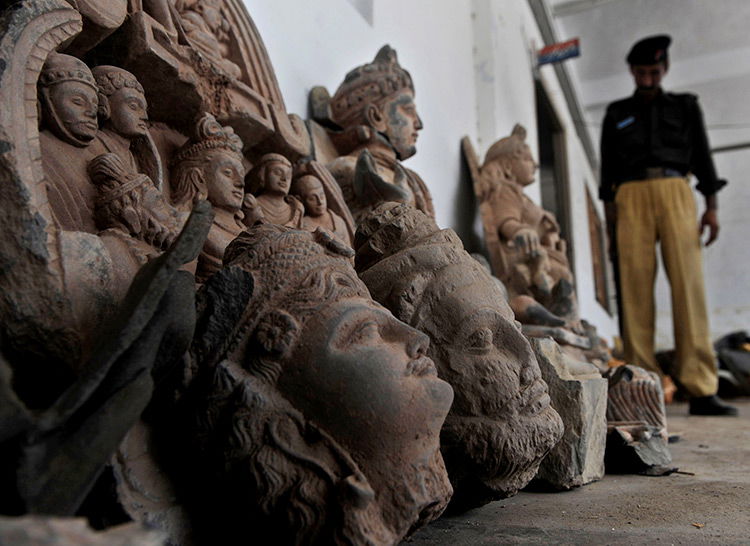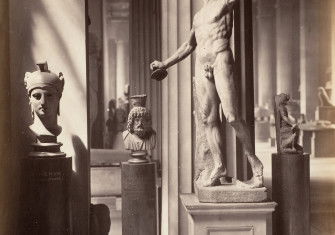Trafficking Culture
Archaeologists and criminologists are looking at ways to combat the illicit trade in antiquities.
 Heritage forms an important part of our identities. Archaeological sites and artefacts let us navigate an uncertain future by helping us to understand who we were and who we are. Confronted with the durability of the material remains of ancient lives, our own lives seem less ephemeral: the people of the past have left their mark and so shall we. The past is a powerful tool. Ancient sites house living tradition and culture. Communities threatened by conflict, disaster, globalisation and cultural loss draw strength from the past to rebuild their future. Archaeological tourism can bring much-needed income to developing countries. The educational opportunities offered by intact heritage sites inspire development in even the poorest locations. The past belongs to everyone and should be used as a force for collective good. But our culture is trickling away. It is looted, trafficked and sold to meet the insatiable international demand for cultural objects. Archaeological looting is a global problem and so far none of our proposed solutions has worked.
Heritage forms an important part of our identities. Archaeological sites and artefacts let us navigate an uncertain future by helping us to understand who we were and who we are. Confronted with the durability of the material remains of ancient lives, our own lives seem less ephemeral: the people of the past have left their mark and so shall we. The past is a powerful tool. Ancient sites house living tradition and culture. Communities threatened by conflict, disaster, globalisation and cultural loss draw strength from the past to rebuild their future. Archaeological tourism can bring much-needed income to developing countries. The educational opportunities offered by intact heritage sites inspire development in even the poorest locations. The past belongs to everyone and should be used as a force for collective good. But our culture is trickling away. It is looted, trafficked and sold to meet the insatiable international demand for cultural objects. Archaeological looting is a global problem and so far none of our proposed solutions has worked.
Many countries have enacted laws that make antiquities the collective property of the public. In these places, archaeological sites can only be excavated by trained professional researchers with proper permits. Artefacts – even those found by chance – must be registered with the authorities and often cannot be sold. Export of antiquities is strictly regulated and to take an artefact out of the country without a permit is considered smuggling. These governments are tasked with the investigation of archaeological sites, the preservation of historic places and the foundation of museums. In other words, they make sure that the past is available to the public and to future generations.
Yet where there is demand, a supply will be found. Four idols robbed from a temple in India; six 200-year-old silver vessels taken from a Colombian church; a man in Guatemala caught trying to sell Maya artefacts on the Internet; illegal metal detecting at Hadrian’s Wall and reports of antiquities theft in Iraq and Syria. Buyers are willing to pay large amounts of money for the best antiquities and criminal networks traffic illegally sourced artefacts to feed this market. Antiquities become commodities: they are bought, sold and privately owned. Despite local laws and international agreements that say otherwise, the material remains of the past belong to whoever can afford to pay for them.
Inevitably buyers in wealthy countries can afford antiquities and those in poorer countries cannot and so cultural objects flow from the developing to the developed world in a steady stream. Once private buyers obtain an antiquity, they can choose to put it on public display or they can keep them to themselves. They can properly care for the antiquity, or they can smash it. There is nothing to stop them from doing so. In a very real sense, once an antiquity enters the private market, it is lost to us.
Above: satellite images from Google Maps of Apamea, Syria in 2007 and 2012, illustrating extent of looting. Slide cursor or finger across image to compare.
Archaeologists do not simply study artefacts, we study everything above, below and around objects to reconstruct the story of when, how and why they came to be where they are. Context is what all archaeology is built upon; an artefact without context tells us very little. When an archaeological site is looted and destroyed and artefacts are smuggled and sold, their context is irrecoverable. Everything that the artefact could have told us is gone for good. Although illicit antiquities in museum cases and auction catalogues may be beautiful, they represent a massive loss to our collective heritage.
Today most of the antiquities available on the market are the product of some sort of criminal activity, be it illegal digging, smuggling or illicit sale. They represent the wilful destruction of the past purely for profit. Yet there is little international oversight of the antiquities trade and very few opportunities to disrupt antiquities-trafficking networks. We are at a point where we can predict that during any given conflict museums will be at risk from theft and archaeological sites will be looted, but there is little anyone can do but condemn the destruction. International actions are usually too little, too late.
I am trying to change this. In 2012 my colleagues and I at the University of Glasgow formed the Trafficking Culture Project, which is aimed at shedding light on some of the darkest corners of the illicit trade in antiquities. Based at the Scottish Centre for Crime and Justice Research, our team of archaeologists, criminologists and experts in law are applying criminological techniques to understanding this archaeological problem for the first time, with some interesting results.
We have defined statue trafficking in Cambodia as a form of organised crime and traced the transnational criminal networks that move these stolen gods from temples to the market. We have analysed how the theft of centuries-old religious objects from Bolivian village churches contribute to community insecurity. We have explored how stolen antiquities from Greece and Rome are laundered through auction houses and have uncovered tax fraud schemes in the United States and Australia that involve respectable museums. We have compared aspects of the illicit trade in antiquities with the illicit trades in fossils, orchids and drugs to see if any comparative patterns emerge. This and more, in only three years. There is so much to do and, so far, we are just scratching the surface.
Ultimately our goal is to gather the information needed to preserve our heritage. We are trying to figure out what works and what does not so that lawmakers can make better heritage protection laws, so that stakeholders can improve site security and so that illicit antiquities buyers can be exposed. We want not just to condemn acts of heritage destruction, but also to prevent that destruction in the first place and to protect archaeological context by stopping looting before it starts. This is hard work, but someone has to do it or there will soon be nothing left.
Donna Yates is a Leverhulme Early Career Fellow in the Scottish Centre for Crime and Justice Research at the University of Glasgow.





